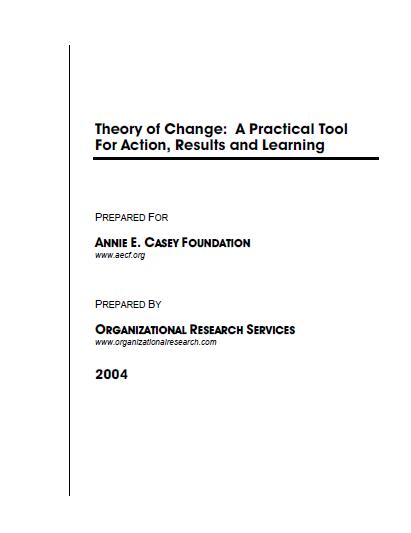The label theory of change is often referred to by other terms, such as pathway of change, engine of change, blueprint, logic model and theory of action. Regardless of the label, a theory of change offers a picture of important destinations and guides you on what to look for on the journey to ensure you are on the right pathway. As Alice observed in Wonderland, ³If you don’t know where you are going, any road will take you there.”” In other words, without a theory of change, a community is vulnerable to wandering aimlessly. Communities and their partners have too much at stake to be aimless, amorphous or random in their actions. The theory of change is a practical and essential part of a successful transformation effort. Theories of change come in many shapes and sizes. You can use different techniques to match your community’s tolerance for “”planning”” versus “”doing.”” One recommended approach is to develop an outcome map, a visual diagram that depicts relationships between initiative strategies and intended results. These results will include both short- and longer-term outcomes and may also reflect changes at different levels, such as individuals, organizations, systems and communities.
 There is no right or wrong way to draw an outcome map; each map will look different, depending on the community’s unique needs and preferences. The important thing is to listen to the views of your community so that your map reflects your community’s view of how change occurs. Additionally, it is valuable to document the assumptions that underlie your initiative, including philosophies, principles or values; ways to work together; community context and other assumptions on which you have based your change effort. These assumptions can be presented in a list format or as a succinct narrative statement. Thus, you will generate two products as part of your theory of change work: 1. An outcome map 2. A list of assumptions about change
There is no right or wrong way to draw an outcome map; each map will look different, depending on the community’s unique needs and preferences. The important thing is to listen to the views of your community so that your map reflects your community’s view of how change occurs. Additionally, it is valuable to document the assumptions that underlie your initiative, including philosophies, principles or values; ways to work together; community context and other assumptions on which you have based your change effort. These assumptions can be presented in a list format or as a succinct narrative statement. Thus, you will generate two products as part of your theory of change work: 1. An outcome map 2. A list of assumptions about change
Download the PDF
Format





